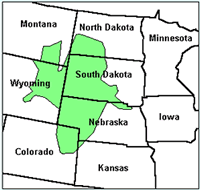
Dakota
Dakota belongs to the Dakota branch of the Siouan-Catawban language family. Its closest relatives are Assiniboine, Lakota, and Stoney (Ethnologue) spoken in widely scattered groups in South-Central Canada and North-Central United States. There were some 25,000 speakers of all Siouan dialects among an ethnic population of slightly over 100,000 (Ethnologue).
Status

Dialects
The linguistic designation of languages/dialects and the way the communities of speakers refer to themselves do not always coincide. For instance, although linguists consider Lakota and Dakota to be dialects of one language, the speakers of these languages refer to themselves as Dakota and Lakota. In addition, tribal designations make the distinctions even more complicated.
Structure
Sound system
There are some differences in pronunciation between Dakota and Lakota. The description below pertains to Lakota. Consonants and vowels usually alternate in Lakota words. Clusters do not exceed two consonants and usually occur at the beginning of words. Most words end in a vowel.
Vowels
Lakota has five oral and three nasal vowels. Nasalization makes a difference in word meaning. In the table below, nasal vowels are marked with a tilde. Orthographically, nasal vowels are sometimes written with a following ƞ, ŋ, or n, and sometimes with ogoneks underneath, e.g., į ą ų.
| Close |
i, ĩ
|
. |
u, ű
|
| Mid |
e
|
o
|
|
| Open |
a, ã
|
Consonants
Lakota has 26-28 consonants, depending on the analysis. They include voiced/voiceless, plain/aspirated and ejective sounds.
- Aspirated stops consist of a closure followed by a release accompanied by either glottal or velar friction. When the release has glottal friction, the stops are very much like English p, t, k in pat, tat, chat, cat. Release with glottal friction occurs before the vowels /i, ĩ, u, ű/. Before /a, ã, o/ aspiration has a velar release. It is no equivalent in English. Aspiration is marked in IPA by a raised [ʰ], as in the table below.
- Ejective consonants are produced by a simultaneous release of two closures, one in the mouth at the position of the stop consonant, the other in the larynx at the glottis. When the compressed air resulting from the double closure is released, there is an audible crack. Ejective consonants are marked with an apostrophe.
| Bilabial | Palatal | |||||||
|---|---|---|---|---|---|---|---|---|
| Stops | voiceless | plain |
p
|
t
|
c
|
k
|
||
| aspirated |
pʰ
|
tʰ
|
cʰ
|
kʰ
|
||||
| ejective |
p’
|
t’
|
c’
|
k’
|
ʔ
|
|||
| voiced |
(b)
|
(g)
|
||||||
| Fricatives voiceless |
voiceless |
s
|
ʃ
|
x
|
||||
| ejective |
s’
|
ʃ‘
|
ɣ
|
|||||
| voiced |
z
|
ʒ
|
||||||
| Affricates voiceless |
plain | |||||||
| aspirated |
tʃʰ
|
|||||||
| ejective |
tʃ‘
|
|||||||
| Lateral |
l
|
|||||||
| Nasals |
m
|
n
|
|
|||||
| Approximants |
w
|
j
|
||||||
- /c/ has no equivalent in English.
- /ʔ/ = soundless break between the vowels in uh-oh produced by closure of the glottis
- /ʃ/ = sh in shop
- /ʒ/ = s in pleasure
- /tʃ/ = ch in chop
- /x, ɣ/ have no equivalents in English.
- /ŋ/ = ng in song
- /j/ = y in yet
- /b, g/ are rarely used.
Stress and pitch
The first (or only) stressed vowel in Lakota words has a higher pitch and greater loudness than all other vowels in that word. Stress usually falls on the second vowel in the word, but not always. It is always indicated in Lakota but not in Dakota writing.
Grammar
Lakota is a polysynthetic language in which words are formed by adding affixes to stems for indicating grammatical relations and for forming new words.
Nouns
- Lakhota nouns are either simple, e.g., nata ‘head’, or derived. Derived nouns may be either compounds, such as šun’ka ‘dog’ + mani’tu‘wilderness’ = šun’n ma’nitu ‘coyote’, or affixed forms such as o ‘place where’ + gna’ke ‘put away’ = ogna’ke ‘container’.
- The grammatical roles of subject, object, or indirect object may be marked by prefixes or infixes.
- Definite nouns are marked by the articles kin or k’un, e.g., šun’ka kin ‘the dog’.
- The choice of indefinite article depends on the noun class, e.g., animate human, animate nonhuman, inanimate, noncount.
- There are three demonstratives: le’ ‘this’, he’ ‘that’, ka’ ‘yonder’.
- The form of the possessive prefix differs depending on whether the possessions are inalienable (body parts, relatives, pets, essential personal possessions) or alienable (everything else).
- There are no adjectives, instead stative verbs are used as modifiers.
Verbs
Verbs are the most important part of Lakota sentences. They are quite complex.
- Every Lakota verb carries affixes that refer to participants, i.e., the subject, direct object, or indirect object. Verbs may be inflected to indicate the person and number of subjects, direct objects, indirect objects, and possessors of objects. In addition to affixes, all verbal paradigms use the enclitic pi to mark a plural argument. An enclitic is like a suffix, except that it is a separate word.
- Verbs belong to several classes according to their participant types: impersonal (no participants), stative (one object), active intransitive (one subject), transitive (subject and direct object), and ditransitive (subject, direct object, indirect object). They are identified by their personal affixes. For instance, stative verbs refer to states or conditions. They are identified by personal affixes, ma– ‘I’ and ni- ‘you’, e.g., i’-puza ‘thirsty’ and i’-mapuza ‘I am thirsty’. Active intransitive verbs take the personal affixes wa– ‘I’ and ya– ‘you’, e.g., hi’ ‘arrive’ and wahi’ ‘I arrived’.
- Verb stems are formed by compounding nouns, adverbs, and verbs to verb roots, e.g., i’-puza ‘thirsty’ consists of i’– mouth + -puza ‘dry’.
- There are several causative constructions, depending on the nature and intent of causality, e.g., han’ska ‘long’ and yuhan’ska ‘lengthen’.
Lakota forms compound verbs by prefixing a noun, an adverb, or another verb to the basic root.
Word order
The normal word order in Lakota is Subject-Object-Verb. There is no preferred order for direct vs indirect objects.
Vocabulary
Dakota languages tend not to borrow words from other languages. Instead, they use their own linguistic resources to create new words. The languages have many ways to describe various aspects of social behavior, personal attributes, and metaphors based on nature. Various aspects of motion are also finely detailed, e.g., coming to and from a place, out of a place, etc.
Below are a few basic words and sentences in Dakota. Nasal vowels are marked with n after the vowel; č represents sound similar to ch in church.
| Good morning. | Hinhana was’te. |
| Good afternoon | Wic’oka was’te. |
| Thank you. | Pidamaya. |
| Man | Wic’as’a |
| Woman | Winyan |
| Father | Ate |
| Yes | Hau (male speech), han (female speech) |
| No | Hiya |
Below are the numerals 1-10 in Dakota. Nasal vowels are marked with n after the vowel; č represents sound similar to ch in church.
|
1
|
2
|
3
|
4
|
5
|
6
|
7
|
8
|
9
|
10
|
|---|---|---|---|---|---|---|---|---|---|
Writing
Lakota was first recorded in written form by missionaries in 1834. It was used to translate biblical texts. Since then, a number of other Lakota and Dakota spelling systems have been used to write the languages. The Lakota Language Consortium developed a Standard Lakota Orthography which has the following characteristics. .
- The vowels are a, e, i, o, u.
- Nasal vowels are sometimes written with a following ƞ, ŋ, or n, and sometimes with ogoneks underneath, e.g., į ą ų. In Dakota, nasal vowels are written with å after the vowel.
- Pitch accent is marked with an acute accent: á, é, í, ó, ú, áŋ, íŋ, úŋ on stressed vowels in Lakota. It is not marked in Dakota.
- An apostrophe is used for representing the glottal stop.
- The following consonants approximate their IPA values: b, g, h, k, l, m, n, p, s, t, w, z.
- A caron is used for sounds which are not written with Latin letters in IPA: č /tʃ/, ǧ /ʁ/, ȟ /χ/, š /ʃ/, ž /ʒ/. In Dakota, ch is represented by ç.
- Aspirates are written with h: čh, kh, ph, th.
- Ejectives are written with an apostrophe: č’, ȟ’, k’, p’, s’, š’, t’.
Did You Know?
The English word teepee comes from Lakota tipi ‘dwelling’.
Difficulty

There is no data on the difficulty level of Dakota for speakers of English.